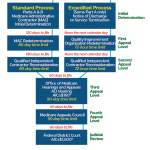
Waldemarus/shutterstock.com
In February 2016, the Centers for Medicare & Medicaid Services (CMS) published the final rule on Medicare Reporting and Returning of Self-Identified Overpayments. This final rule from CMS has now established official policy for timely reporting and returning of Medicare overpayments received by healthcare providers, with a goal to provide clear requirements for reporting and returning overpayments.
Since the enactment of the Affordable Care Act in 2010, providers have been subjected to a statutory 60-day timeline for reporting and returning any and all Medicare overpayments. If providers fail to comply with the 60-day rule, they face liability under the False Claims Act, the Civil Monetary Penalties Law, and the Medicare exclusion authorities for failure to meet the statutory deadline. The final rule was preceded by CMS’s proposed rule published on Feb. 16, 2012, and brings some clarity to issues, such as when an overpayment is considered to be “identified” for purposes of the 60-day deadline, as well as how far providers must look back when identifying overpayments subject to the reporting and returning requirement.
Basic Rule Standards
Under the final rule, a provider or other non-physician provider who has received an “overpayment” must report and return the overpayment by:
- The date that is 60 days after the date on which the overpayment was “identified”; or
- The date any corresponding cost report is due, if applicable.
In the final rule, “overpayment” means any funds that a provider received under Medicare Part A or B to which the person, after applicable reconciliation, is not entitled.
An overpayment is identified when a provider has, or should have through reasonable diligence, determined that they received an overpayment and calculated the amount of the overpayment. With this definition, CMS acknowledges that “identification” of an overpayment involves quantifying the amount, which requires time for a reasonably diligent investigation.
According to CMS, “reasonable diligence” includes:
- Proactive compliance activities conducted in good faith by qualified individuals to monitor the receipt of overpayments; and
- Investigations conducted in good faith and in a timely manner by qualified individuals in response to obtaining credible information of a potential overpayment.
A six-month period as the benchmark is what CMS considers to be a timely investigation, absent extraordinary circumstances. According to CMS, they have calculated a total of eight months (six months for timely investigation and two months for reporting and returning) as a reasonable time, absent extraordinary circumstances. CMS stated that “extraordinary circumstances” may include unusually complex investigations that the provider reasonably anticipates will require more than six months to investigate, such as a Stark Law violation. Specific examples of other types of extraordinary circumstances cited by CMS include natural disasters or a state of emergency.
Look-Back Period
Prior to the new ruling, the guidelines on the look-back period were unclear as they relate to retaining any overpayments, because the Proposed Rule offered a 10-year look-back period to be consistent with the False Claims Act statute of limitations. CMS recognized that a 10-year period would be overly burdensome for providers in terms of retaining records and retrieving information.
According to the Final Rule, overpayments are subject to a six-year look-back period. This means that overpayments must be reported and returned if they have been identified within six years of the date the overpayment was received. Note: the six-year look-back period is not retroactive and went into effect on March 14, 2016.
Reporting & Return Process
Providers must use the reporting process established by the applicable Medicare Administrative Contractor (MAC) to report the overpayment. This may include applicable claims adjustment, credit balance, self-reported refund or other processes set forth by the individual MACs. It is important that if the amount of the overpayment was calculated using a statistical sampling methodology, then the provider must describe the statistically valid sampling and extrapolation methodology in the report.
Keep in mind, CMS has included a provision for overpayments to be suspended if a provider submits a request for an extension to repay any overpayment(s) to their MAC. The deadline will remain suspended until CMS or the MAC rejects the suspended repayment schedule request or the provider fails to comply with the terms of the extended repayment schedule.
Effective Date
Although the final rule was released and went into on effect on March 14, 2016, providers have been subject to the Affordable Care Act’s provisions for timely reporting and returning of Medicare overpayments since March 23, 2010.
CMS states that provisions of the final rule are not retroactive. Providers who reported and/or returned overpayments prior to March 14, 2016, and who made a good faith effort to comply with the Affordable Care Act’s “report and return” requirements, are not expected by CMS to have complied with each provision of the final rule. All providers reporting and returning overpayments on or after March 14, 2016—even overpayments received prior to this date—must comply with the requirements of the final rule.
Implementation for Practices
Although healthcare providers have long been obligated to report and return overpayments, providers should now take key steps to prepare their practice in response to the final rule.
Step 1: Providers should implement or review processes to ensure they respond appropriately regarding a potential overpayment that has credible information. Credible information may include the finding of a single, overpaid claim (which may trigger the need for additional review of charts).
Step 2: Watch for one or more hotline complaints regarding the same or similar payment-related issue and work on identifying any claims that may fall within those complaints
Step 3: Although CMS allows for identifying and quantifying a potential overpayment to occur after a reasonably diligent investigation, providers should be prepared to take no more than six months to complete the investigative process.
Step 4: Providers should maintain records that accurately document their reasonably diligent efforts to demonstrate their compliance with the final rule.
Step 5: Providers should be prepared to look back six years when identifying potential overpayments.
Step 6: Providers should schedule regular proactive auditing of charts to maintain “reasonable diligence.”
Practices should review the Final Rule. It’s important to look at any existing business practice to mitigate risks that may be enforced by this new rule. For assistance with proactive and retroactive self-audits, contact the ACR healthcare auditors at [email protected] to set up a session in your area.
